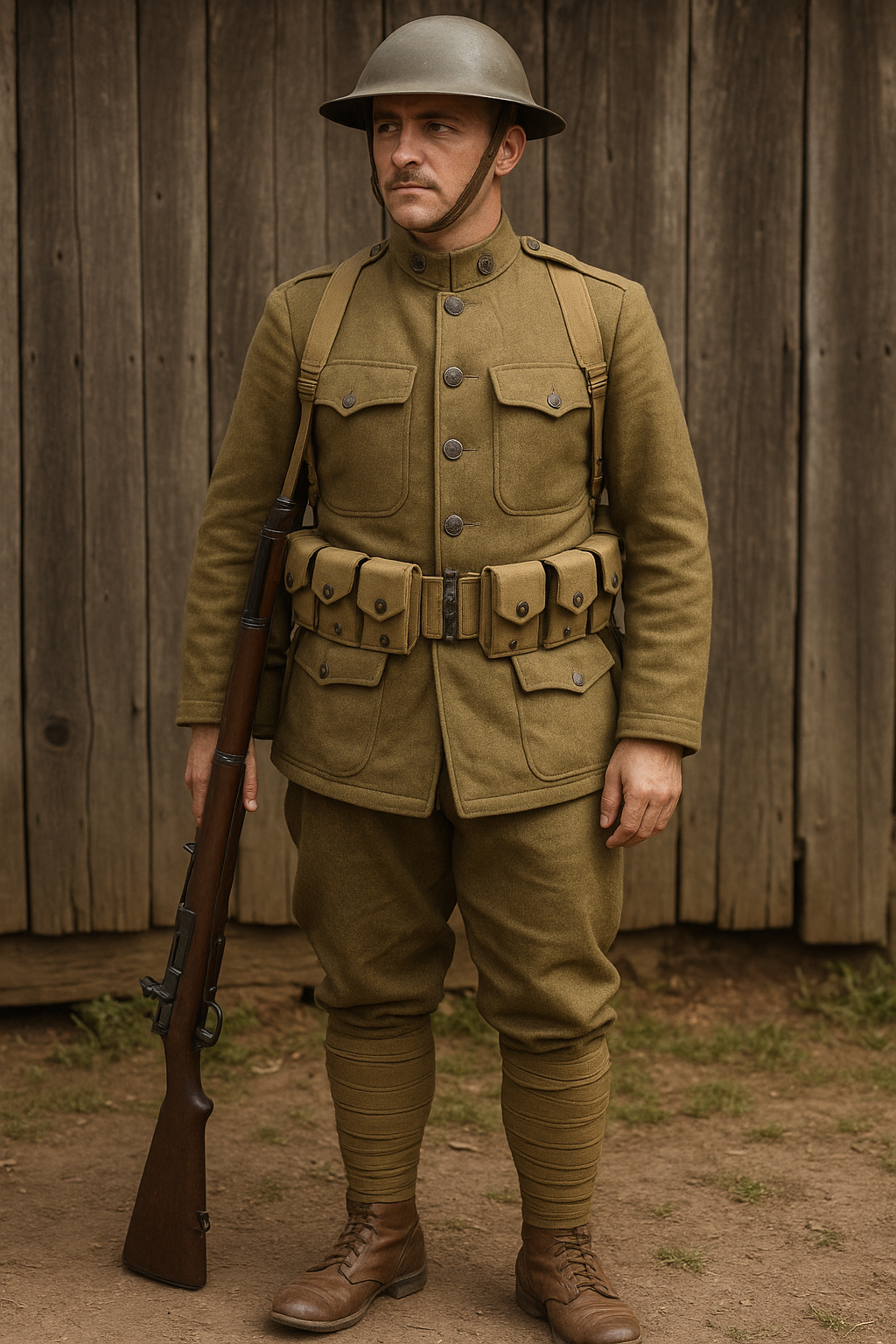
Authentic American WWI Uniform Guide: A Deep Dive into the U.S. Army Uniforms of World War 1
Published on Jul 23, 2025
American WWI Uniforms: A Complete Guide to WW1 U.S. Army Soldier Gear and Style
When the United States entered World War I in 1917, the American Expeditionary Forces (AEF) brought not just manpower to the battlefield but also a distinctive look — the American WWI uniform. The design, rooted in practicality and evolving military needs, reflected a combination of tradition and innovation. This article explores the key components, history, and variations of the WWI US soldier uniform, showcasing why these iconic outfits remain significant even today.
The Evolution of the WWI U.S. Army Uniform
Before entering WWI, the U.S. military used uniforms that were remnants of the Spanish-American War era. However, rapid mobilization for the Great War brought major updates. By the time American forces arrived in Europe, the U.S. Army uniform WW1 had adopted a more modern, durable design suited for trench warfare.
Key Influences:
- British and French military styles, due to U.S. troops training alongside Allied forces.
- Functional updates to cope with the muddy, wet, and harsh conditions of European trenches.
- Emphasis on woolen fabrics for warmth and long wear.
Key Components of the American WWI Uniform
Let’s break down the main items of the WWI US soldier uniform, from head to toe:
1. M1912 and M1917 Tunics
- Wool fabric in olive drab color.
- Standing collar and four-pocket front.
- M1917 version updated with larger pockets and simpler buttons.
2. Trousers (Breeches)
- Wool breeches laced at the calves.
- Designed to be worn with puttees or leggings.
3. Puttees or Leggings
- Wool or canvas wraps for lower legs.
- Protected soldiers from mud, debris, and cold.
4. Steel Helmet (M1917)
- Also known as the "Doughboy helmet", inspired by British Brodie helmet.
- Provided shrapnel protection.
5. Footwear
- Roughout leather service boots.
- Durable for trench conditions, but often water-logged.
6. Overcoat (Greatcoat)
- Heavy wool greatcoat worn in winter months.
- Issued to both officers and enlisted men.
7. Insignia and Rank Badges
Understanding insignia was vital for hierarchy in war zones. Badges indicated:
- Branch of service (infantry, artillery, etc.)
- Unit designation
- Rank
A more in-depth look can be found in this article: WWI US Military Insignia Explained: Army, Navy and USMC Rank Badges
Officer vs. Enlisted Uniform Differences
While the base design was similar, officers had higher-quality materials and tailored fits. Key distinctions included:
- Sam Browne belts (a leather belt with shoulder strap) worn by officers.
- Customized insignia, boots, and personal gear.
- Pistol holsters and binocular cases as part of their loadout.
The Doughboys: America's Fighting Men in Uniform
The term “Doughboy” became synonymous with American infantrymen in WW1. These men were often seen in standard-issue U.S. Army uniform WW1, which earned admiration for its rugged simplicity. The uniform reflected:
- Unity and identity for diverse recruits from across America.
- A practical design that held up in the trenches of France.
To see an even broader perspective, explore our guide:
A Complete Guide to World War 1 Uniforms: From US Doughboys to French Infantrymen
Why Collectors and Reenactors Value Authentic WWI Uniforms
Enthusiasts of military history are drawn to the American WWI uniform for its historic accuracy and symbolism. Whether for reenactments, museum displays, or private collections, authenticity matters.
Many collectors seek high-quality reproductions of:
- M1917 tunics and breeches
- US AEF gear like canteens, mess kits, belts
- Helmet insignia and collar discs
Explore our curated collection of authentic replicas and gear at:
WW1 US AEF Uniforms and Gear Collection
Unique Features of the WWI US Army Uniform
What set the US Army uniform WW1 apart from others?
Wool Over Cotton
Wool was used in nearly all garments. Its insulating quality made it ideal for European winters, although it was hot in warmer weather.
Olive Drab Color Scheme
This muted green-brown hue became the new military standard — less visible to enemies and perfect for the muddy battlefields.
Button and Collar Insignia
Every unit and branch had its own insignia, proudly displayed through brass collar discs or shoulder patches.
Variations by Branch and Unit
While most American soldiers wore the same standard uniform, minor changes appeared based on:
- Branch: Artillery, Cavalry, Engineers, etc.
- Specialty: Signal Corps, Tank Corps, Medical Staff
- Nationality: African American units and Native American soldiers sometimes had different allocations.
Final Thoughts: Honoring History Through the American WWI Uniform
The WWI US soldier uniform is more than just military clothing — it’s a symbol of American resilience, adaptation, and global commitment. Understanding the details of the U.S. Army uniform WW1 deepens our appreciation for the Doughboys who served and the legacy they left behind.
Whether you're a history enthusiast, a reenactor, or a collector, you’ll find quality resources and replicas at Paddelaters — your dedicated source for authentic American WWI uniforms and gear.
